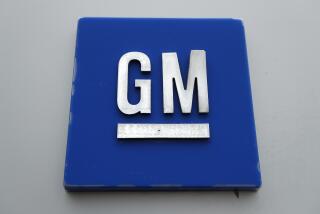U.S. to Probe Railroad Over Fatal Crashes
- Share via
Reacting to three freight train crashes that killed seven people in less than two months, federal regulatory officials this week announced an unprecedented, round-the-clock inspection of Union Pacific Railroad.
Federal Railroad Administrator Jolene M. Molitoris said a preliminary review of the crashes--two in Texas and one in Kansas--has found evidence of “critical safety deficiencies” at the nation’s largest railroad.
She did not elaborate, but Federal Railroad Administration officials said that over the past year, problems have been noted with Union Pacific’s dispatch, train control, training and hazardous materials procedures. In many cases, train crews and supervisors were found to be fatigued and overworked.
“We are alarmed at what appears to be a fundamental breakdown in the safety culture of the railroad,” James Schultz, the agency’s associate administrator for safety, said Wednesday. “Jerry David, the president and chief executive officer of the railroad, has pledged his personal commitment to fix these problems. . . . We’re not talking about incremental fixes, we’re talking about fundamental change.”
The systemwide probe will concentrate on the railroad’s facilities in Los Angeles; Sacramento; Chicago; Denver; Fort Worth; Houston; San Antonio; Kansas City, Mo.; Omaha; Pocatello, Idaho; and Portland, Ore., the agency said.
The investigation, which will be conducted by more than 80 specially trained inspectors, is part of an agency effort to take a more active and visible role in developing and enforcing safety regulations.
Accused by the chairman of the National Transportation Board and other critics of foot-dragging in the past, the railroad agency has vowed to do better, and Molitoris has said that “aggressive action” will be the hallmark of her term as agency chief.
The safety board is conducting its own investigations to determine the cause of the three Union Pacific accidents.
The first occurred June 22, when two freight trains crashed head-on on a stretch of single track about 30 miles west of San Antonio. The collision killed two crewmen and two men who had sneaked a ride on the train.
Safety board sources say the accident appears to have been caused by a dispatcher’s failure to relay a message telling the northbound train to wait on a siding until the southbound train had passed.
The second crash, on July 2, occurred when a train on a siding moved forward into a switch and struck the side of a passing freight near Delia, Kan. The engineer of the train on the siding was killed. Robert Lauby, the safety board’s chief rail crash investigator, said crew fatigue may have been a factor in the accident.
The third crash occurred last week near Fort Worth. Lauby said four unmanned locomotives had been parked on a downhill siding, but the hand brake apparently had been set on only one of them. When that brake apparently failed, the locomotives started to roll, coasting onto a main line and eventually reaching speeds of close to 60 mph.
The locomotives rolled undetected for almost 10 miles before slamming head-on into another locomotive pulling a freight train. Two engineers on the freight train were killed.
Officials said there have been five other incidents since January that claimed the lives of five other Union Pacific employees. Details of these were not provided.
The Federal Railroad Administration’s Schultz said there was at least one other incident in which a potentially fatal Union Pacific crash was narrowly averted.
“Last January, near Chicago, a dispatcher put a loaded coal train on the same track as a passenger train that was headed in the opposite direction,” he said. “Fortunately, there was a redundant safeguard--a signal system--that prevented a head-on collision.”
Mike Furtney, a Union Pacific spokesman, said that while the fatal accidents are tragic, they do not reflect a trend, either for Union Pacific or the railroad industry as a whole.
Over the long term, accidents are down about 50%, Furtney said. “The rail industry is safe and getting safer.”
During the round-the-clock railroad administration probe, inspectors will ride with train crews, monitor the railroad’s dispatching network and talk to labor representatives, managers and contractors.
A merger last year with the Southern Pacific railroad has made the Union Pacific the largest rail operation in the country, with more than 36,000 miles of track in the western third of the United States.
More to Read
Sign up for Essential California
The most important California stories and recommendations in your inbox every morning.
You may occasionally receive promotional content from the Los Angeles Times.










